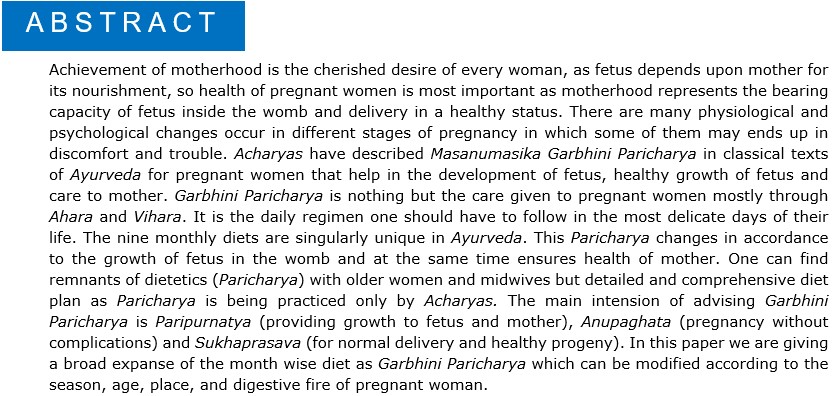Scientific applicability in day-to-day practice on Granthokta Garbhini Paricharya
DOI:
https://doi.org/10.21760/jaims.9.3.28Keywords:
Garbhini Paricharya, Ayurveda, Pathya, Apathya, MasanumasikaAbstract
Achievement of motherhood is the cherished desire of every woman, as fetus depends upon mother for its nourishment, so health of pregnant women is most important as motherhood represents the bearing capacity of fetus inside the womb and delivery in a healthy status. There are many physiological and psychological changes occur in different stages of pregnancy in which some of them may ends up in discomfort and trouble. Acharyas have described Masanumasika Garbhini Paricharya in classical texts of Ayurveda for pregnant women that help in the development of fetus, healthy growth of fetus and care to mother. Garbhini Paricharya is nothing but the care given to pregnant women mostly through Ahara and Vihara. It is the daily regimen one should have to follow in the most delicate days of their life. The nine monthly diets are singularly unique in Ayurveda. This Paricharya changes in accordance to the growth of fetus in the womb and at the same time ensures health of mother. One can find remnants of dietetics (Paricharya) with older women and midwives but detailed and comprehensive diet plan as Paricharya is being practiced only by Acharyas. The main intension of advising Garbhini Paricharya is Paripurnatya (providing growth to fetus and mother), Anupaghata (pregnancy without complications) and Sukhaprasava (for normal delivery and healthy progeny). In this paper we are giving a broad expanse of the month wise diet as Garbhini Paricharya which can be modified according to the season, age, place, and digestive fire of pregnant woman.
Downloads
References
Dutta D. C., Text book of Obstetrics, 6th Edition, New Delhi (India): New Central Book Agency (P) Ltd; 2006.
Sastri K., Charaka Samhita, Sharira Sthana, Chapter no 8, Verse no 32, Chaukhamba Orientalia, Varanasi, 2015.
Murthy K.R.S., Sushruta Samhita, vol 2, 1st edition, Sharira sthana, Chapter no 10, Verse no 2-5, Chaukhamba Orientalia, Varanasi, 2002; 252-255.
Murthy K. R. S., Astanga Hrdaya Samhita of Vagbhata, Sharira Sthana, Chapter no1, Verse no 16, 44-47, 10th edition, Chaukhamba Krishnadas Academy Pune, 2010.
Ramavalamba., Harita Samhita with Hindi commentary, 1st edition, Tritiya Sthana, Chapter no 49, Verse no 1-3, Prachya Prakashana, Varanasi, 1985; 404.
Tiwari P. V., Ayurveda Prasuti Tantra and Stree Roga, 1st Part, Chapter 5, 2nd Edition, Chaukhamba Orientalia, Varanasi, 1999; (Reprint) 2001; 226-233.
Murthy K.R.S, Sushruta Samhita of Sushruta,1st edition, Sharira Sthana, Chapter no 3, Verse no 12-14, Chaukhamba Orientalia, Varanasi, 2002.
Murthy K. R. S., Ashtang Hridaya by Acharya Vagbhata, Shareera Sthana, Chapter no 1, Verse no 49, 10th edition, Chaukhambha Orientalia, Varanasi, 2010.
Shrisatyapal Bhisagaacharya, Hindi commentary Commentor on Kashyap Samhita Sharir sthana 8, Verse no 181, 4th Edition, Varanasi, Chaukhamba Bharti Academy.















